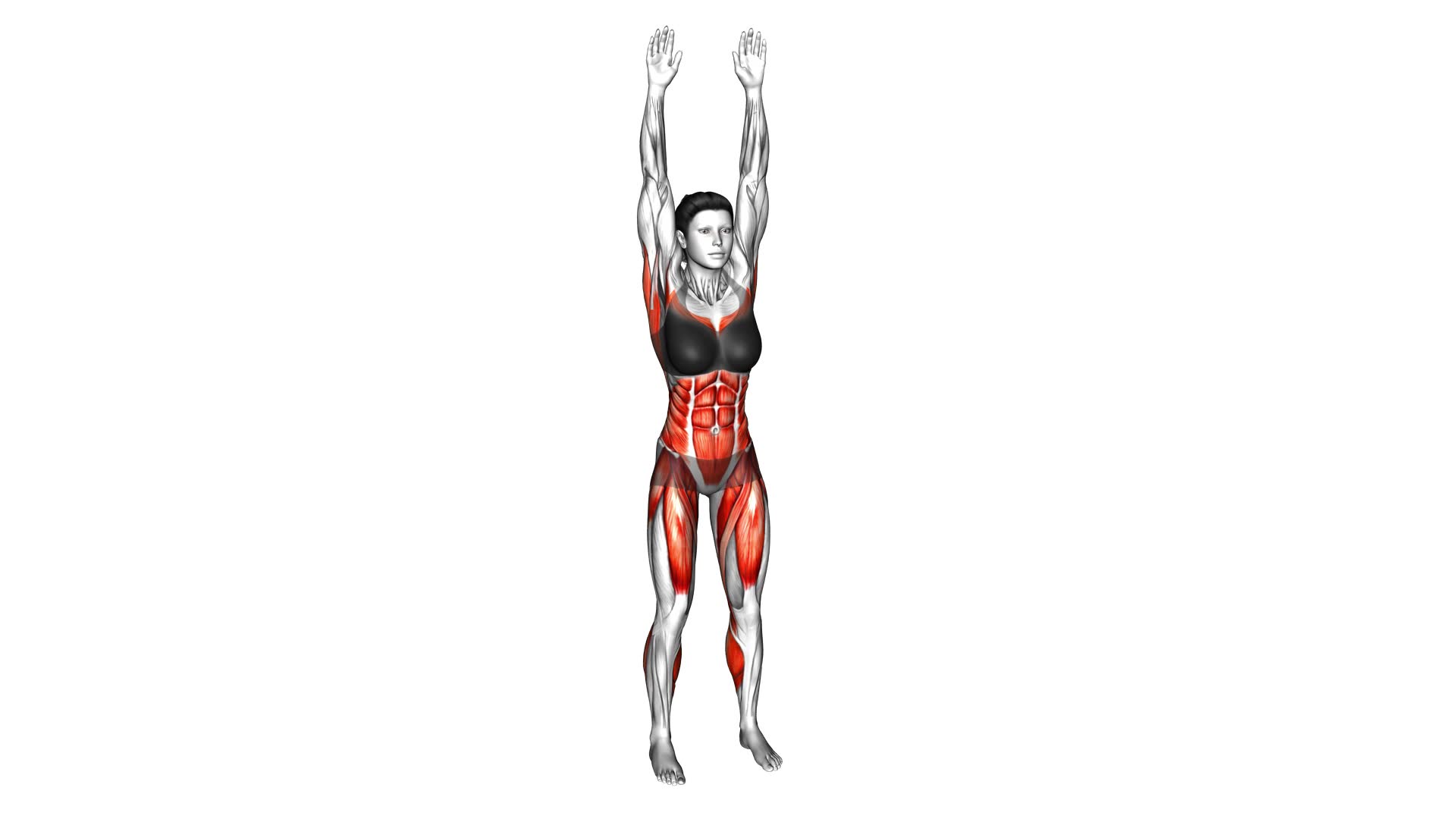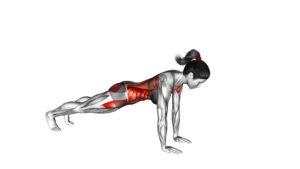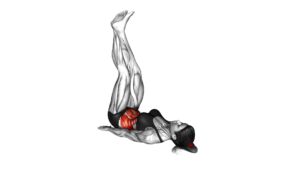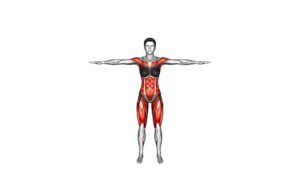Knee Leg Lifts (female) – Video Exercise Guide & Tips

Looking to tone your legs and strengthen your knees? Look no further than knee leg lifts! In this video exercise guide, we'll show you the proper form and technique for this effective workout.
Watch This Exercise Video
Whether you're a beginner or advanced, we've got variations and modifications to suit your fitness level. Avoid common mistakes and get tips for increasing intensity.
Get ready to sculpt your legs with our sample knee leg lifts workout routine. Let's get started!
Key Takeaways
- Knee leg lifts improve strength, stability, and flexibility in the lower body.
- Proper form and technique include engaging the core and using controlled movements.
- Variations and modifications, such as using resistance bands or weighted ankles, can increase the challenge and engage muscles more.
- It is important to maintain proper knee alignment, engage the core muscles, and focus on slow and controlled movements to prevent injury.
Benefits of Knee Leg Lifts
Experience the numerous benefits of knee leg lifts, including improved strength, stability, and flexibility. Knee leg lifts are a versatile exercise that targets multiple muscle groups in the lower body. There are different types of knee leg lifts that you can incorporate into your workout routine to vary the intensity and target specific muscles.
One type of knee leg lift is the straight leg lift. To perform this exercise, lie on your back with your legs straight and lift one leg towards the ceiling, keeping it straight throughout the movement. This targets the quadriceps, hamstrings, and glutes.
Another type is the bent leg lift. Lie on your back with your knees bent and lift one leg towards your chest, keeping the knee bent. This exercise primarily targets the hip flexors and lower abdominal muscles.
To avoid injury during knee leg lifts, it's important to maintain proper form and technique. Start with a light warm-up to prepare your muscles for the exercise. Engage your core and focus on using the targeted muscles to lift your legs, rather than relying on momentum. Avoid jerky movements or lifting your legs too high, as this can strain your lower back. Gradually increase the intensity and duration of your knee leg lifts as your strength and stability improve.
Incorporating knee leg lifts into your fitness routine can help improve your overall lower body strength, stability, and flexibility.
Proper Form and Technique
To perform knee leg lifts with proper form and technique, you should focus on engaging your core and using controlled movements to lift your legs.
One of the common misconceptions about knee leg lifts is that you need to lift your legs as high as possible. However, the key is to maintain control and stability throughout the exercise.
Start by lying on your back with your legs extended and your arms by your sides. Bend your knees and place your feet flat on the floor. Engage your core by drawing your navel towards your spine.
Slowly lift one leg off the ground while keeping your core engaged and your lower back pressed into the floor. Exhale as you lift your leg and inhale as you lower it back down. Repeat on the other side.
Remember to keep your movements controlled and avoid any jerking or swinging motions. By focusing on proper form and incorporating the correct breathing technique, you'll maximize the effectiveness of knee leg lifts and reduce the risk of injury.
Variations and Modifications
Try incorporating different variations and modifications to challenge yourself during knee leg lifts. By adding variations and modifications to your routine, you can target different muscles, increase the intensity, and prevent boredom.
Here are three options to consider:
- Resistance Bands: Attach a resistance band to your ankles or knees to add resistance to the movement. This will engage your muscles even more and make the exercise more challenging.
- Weighted Ankles: Place ankle weights around your ankles to increase the resistance and intensity of the exercise. This will help strengthen the muscles in your legs and glutes even further.
- Single-leg Knee Leg Lifts: Instead of lifting both legs at the same time, try lifting one leg at a time. This variation won't only challenge your core stability but also target each leg individually, ensuring balanced strength development.
Remember to start with lighter resistance or modifications and gradually increase as you get stronger. It's important to listen to your body and only go as far as you can comfortably handle.
Common Mistakes to Avoid
When performing knee leg lifts, it's important to avoid common mistakes that can hinder your progress.
One common mistake to avoid is improper knee alignment, which can put unnecessary strain on your joints.
Additionally, make sure to engage your core muscles throughout the exercise to maintain stability and maximize effectiveness.
Lastly, focus on slow and controlled movements to ensure proper form and prevent injury.
Proper Knee Alignment
Ensure that your knees are properly aligned throughout the knee leg lifts exercise. Proper knee alignment is crucial to avoid knee pain and maximize the effectiveness of knee strengthening exercises. Here are three key points to keep in mind:
- Maintain a neutral knee position: Avoid letting your knees collapse inward or flare outward. Keep them in line with your hips and ankles to distribute the workload evenly.
- Engage your core: A strong core helps stabilize your body and maintain proper knee alignment. Activate your abdominal muscles by drawing your belly button towards your spine throughout the exercise.
- Control your movement: Avoid swinging or jerking your legs during the leg lifts. Move slowly and with control to ensure that your knees stay aligned and your muscles are properly engaged.
Engaging Core Muscles
To engage your core muscles effectively during knee leg lifts, focus on maintaining a strong and stable center throughout the exercise. Engaging your core is crucial for proper form and to maximize the benefits of this exercise.
One common mistake to avoid is allowing your lower back to arch or sag. This can put unnecessary strain on your spine and decrease the effectiveness of the exercise. Instead, draw your belly button in towards your spine and activate your deep abdominal muscles. This will help to stabilize your pelvis and maintain a neutral spine position.
Additionally, avoid using momentum to lift your legs. Instead, use the strength of your core muscles to control the movement.
Incorporating strengthening exercises and core stability training into your routine can further enhance your ability to engage and activate your core muscles during knee leg lifts.
Slow and Controlled Movements
How can you ensure that you're performing knee leg lifts with slow and controlled movements? Proper form and technique are essential for maximizing the benefits of knee leg lifts. Here are three key tips to help you maintain a slow and controlled tempo during this exercise:
- Focus on your breathing: Inhale as you lower your leg and exhale as you raise it, keeping your movements controlled and steady.
- Engage your core: Activate your abdominal muscles to provide stability and control throughout the exercise.
- Modify the exercise if needed: If you find it challenging to maintain a slow tempo, you can reduce the range of motion or perform the exercise with bent knees until you build enough strength and control.
Tips for Increasing Intensity
To increase the intensity of your knee leg lifts, there are a few key points to keep in mind.
First, consider incorporating progressive weight resistance by using ankle weights or holding a dumbbell between your feet.
Secondly, vary the tempo and repetitions of your leg lifts to challenge your muscles in different ways.
Finally, try incorporating resistance bands into your knee leg lift routine to add an extra level of resistance and difficulty.
Progressive Weight Resistance
Increase the intensity of your knee leg lifts by progressively adding more weight. This technique, known as progressive weight resistance, is essential for achieving muscle growth and maximizing the effectiveness of your workouts.
Here are three tips for increasing the intensity of your knee leg lifts:
- Start with lighter weights: Begin with a weight that challenges you but still allows you to maintain proper form and complete the exercise with control.
- Gradually increase the weight: As you become stronger, gradually add more weight to your knee leg lifts. Aim to increase the resistance by 5-10% each week to ensure progressive overload.
- Listen to your body: Pay attention to how your body feels during the exercise. If the weight feels too heavy or you experience pain, decrease the weight or seek guidance from a professional.
Tempo and Repetitions
To maximize the intensity of your knee leg lifts, focus on controlling the tempo of each repetition. Tempo control refers to the speed at which you perform the exercise. By slowing down the movement and maintaining control throughout, you engage your muscles more effectively, leading to greater strength and muscle development.
Aim for a slow and controlled downward phase, followed by a powerful upward phase. Additionally, consider varying your rep range to further increase intensity. Higher rep ranges, such as 12-15 reps per set, can help build muscular endurance, while lower rep ranges, like 6-8 reps per set, promote strength and power.
Experiment with different tempos and rep ranges to find what works best for you and your fitness goals.
Incorporating Resistance Bands
To increase the intensity of your knee leg lifts, try incorporating resistance bands into your workout routine. Resistance band exercises can provide added resistance and challenge to your leg lifts, helping to strengthen and tone your muscles even more effectively. Here are three tips for incorporating resistance bands:
- Attach the resistance band to a sturdy anchor point, such as a door handle or a pole, to create tension.
- Place the resistance band just above your knees or ankles to engage your hip abductors and add an extra challenge to your leg lifts.
- Experiment with different resistance band strengths to find the level of resistance that's challenging but still allows you to maintain proper form.
By adding resistance bands to your knee leg lifts, you can take your workout to the next level and continue to progress in your fitness journey.
Now let's move on to the next section and explore a sample knee leg lifts workout routine.
Sample Knee Leg Lifts Workout Routine
Start by incorporating knee leg lifts into your workout routine for stronger and toned legs. Knee leg lifts are a great exercise that targets the muscles in your thighs and glutes. To get the most out of this exercise, you can make some modifications and adjust the tempo.
If you want to make knee leg lifts more challenging, you can add ankle weights or resistance bands. These modifications will increase the resistance and make your muscles work harder. It's important to start with lighter weights or bands and gradually increase the intensity as you get stronger.
In terms of tempo, you can vary the speed at which you perform knee leg lifts. Slow and controlled movements can help you focus on engaging the targeted muscles and improve your balance. On the other hand, performing knee leg lifts at a faster pace can add a cardiovascular component to your workout and increase calorie burn.
A sample knee leg lifts workout routine could include 3 sets of 10-12 repetitions on each leg. Start with the basic knee leg lift exercise and gradually progress to the modified versions. Remember to listen to your body and adjust the intensity as needed.
Incorporating knee leg lifts into your workout routine can help you achieve stronger and more toned legs. Just remember to make modifications and adjust the tempo to keep challenging yourself and continue seeing progress.
Frequently Asked Questions
How Many Calories Can You Burn by Doing Knee Leg Lifts?
You can burn a significant amount of calories by doing knee leg lifts. This exercise engages your core, glutes, and thigh muscles, making it a great addition to your overall fitness routine.
Knee leg lifts also help improve balance and stability. To incorporate them into a full body workout, you can combine them with other exercises like squats, lunges, and planks.
Remember to maintain proper form and gradually increase the intensity for maximum benefits.
Can Knee Leg Lifts Help in Reducing Cellulite on the Thighs?
Knee leg lifts can be an effective exercise for reducing cellulite on the thighs. These thigh toning exercises target the muscles in that area, helping to improve muscle tone and decrease the appearance of cellulite.
While knee leg lifts alone may not completely eliminate cellulite, they can be a part of a comprehensive cellulite remedy routine that includes a healthy diet, regular exercise, and other targeted exercises for the thighs.
How Long Does It Take to See Results From Doing Knee Leg Lifts?
To see results from knee leg lifts, the optimal frequency is to do them three to five times a week.
However, keep in mind that everyone is different and results may vary. Consistency and proper form are key.
Common mistakes to avoid include using momentum instead of your muscles, not engaging your core, and lifting your leg too high.
Stay dedicated and you should start seeing results within a few weeks.
Are Knee Leg Lifts Suitable for Individuals With Knee Injuries?
Knee leg lifts can be a beneficial exercise for strengthening your legs and core.
However, if you have a knee injury, it's important to consult with a healthcare professional before attempting this exercise. They can provide guidance on whether knee leg lifts are suitable for you and suggest modifications or alternative exercises that won't put excessive strain on your knee.
Safety should always be a priority when it comes to exercising with knee injuries.
Can Knee Leg Lifts Help in Improving Balance and Stability?
Knee leg lifts can be beneficial for improving balance and stability. By targeting the muscles in your legs, these exercises help to strengthen and stabilize the joints, which can improve coordination and prevent falls.
Incorporating knee leg lifts into your fitness routine can be a great way to enhance your overall stability, making everyday activities easier and reducing the risk of injury. Remember to start slowly and consult with a healthcare professional if you have any concerns.
Conclusion
Incorporating knee leg lifts into your workout routine can help strengthen and tone your leg muscles, particularly the quadriceps and glutes.
By maintaining proper form and technique, avoiding common mistakes, and gradually increasing intensity, you can maximize the benefits of this exercise.
Whether you're a beginner or more advanced, there are variations and modifications available to suit your fitness level.
So, add knee leg lifts to your routine and enjoy the results!

Author
Years ago, the spark of my life’s passion ignited in my mind the moment I stepped into the local gym for the first time. The inaugural bead of perspiration, the initial endeavor, the very first surge of endorphins, and a sense of pride that washed over me post-workout marked the beginning of my deep-seated interest in strength sports, fitness, and sports nutrition. This very curiosity blossomed rapidly into a profound fascination, propelling me to earn a Master’s degree in Physical Education from the Academy of Physical Education in Krakow, followed by a Sports Manager diploma from the Jagiellonian University. My journey of growth led me to gain more specialized qualifications, such as being a certified personal trainer with a focus on sports dietetics, a lifeguard, and an instructor for wellness and corrective gymnastics. Theoretical knowledge paired seamlessly with practical experience, reinforcing my belief that the transformation of individuals under my guidance was also a reflection of my personal growth. This belief holds true even today. Each day, I strive to push the boundaries and explore new realms. These realms gently elevate me to greater heights. The unique combination of passion for my field and the continuous quest for growth fuels my drive to break new ground.







